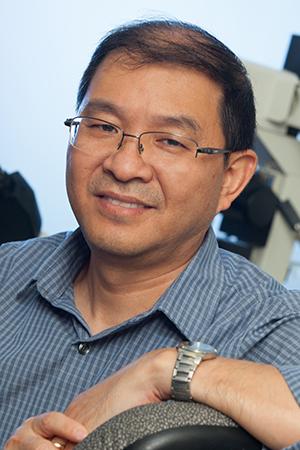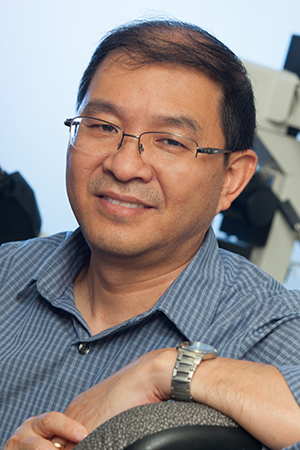Wang lab identifies key mechanism in cell division


February 2016
In the dozens of labs in the College of Medicine, researchers strive to plug gaps in their knowledge. They often know that some cellular process is occurring but not exactly how. Once they know how, they can explore ways to either assist beneficial processes or obstruct harmful ones.
The lab of Biomedical Sciences Professor Yanchang Wang recently discovered an important how related to the all-important process of cell division. The question was how the cell, after braking in response to a glitch in the division process, manages to let off the brake and hit the gas again. The answer that Wang’s team discovered is published in the prestigious journal Cell Reports.
Graduate student Michael Bokros, one of the first authors of the paper, explains the significance of the complex process by which so-called parent cells produce two daughter cells:
“The main goal of cell division is to copy the DNA, package both copies into chromosomes, and segregate each copy into the daughter cell,” Bokros said. “This is critical because each cell needs a copy of the DNA. After the DNA is copied, a large protein structure called the ‘kinetochore’ is constructed on top of the DNA. Next, strings (‘microtubules’) emanating from each daughter cell attach to the kinetochore and segregate each pair of chromosomes.”
There’s a lot at stake: Mistakes in chromosome segregation, he noted, contribute to cancer development.
“This is such an important issue,” Bokros said, “that the cells have developed a mechanism to detect these incorrectly attached kinetochores and stop the cell from dividing, which is termed the ‘spindle assembly checkpoint.’”
But after the cell stops dividing, how does it know when it’s safe to start up again?
.jpg) The Wang lab — using budding yeast, in which the checkpoint system is similar to humans’ — has identified a mechanism that actually disassembles the spindle assembly checkpoint. A lighthearted illustration by College of Medicine medical illustrator Jodi Slade, featured on the cover of Cell Reports, helps describe the discovery.
The Wang lab — using budding yeast, in which the checkpoint system is similar to humans’ — has identified a mechanism that actually disassembles the spindle assembly checkpoint. A lighthearted illustration by College of Medicine medical illustrator Jodi Slade, featured on the cover of Cell Reports, helps describe the discovery.
Inside the house in the illustration is a protein called Bub1 with phosphate companions. They’re operating the checkpoint, hitting the brakes when they detect a mistake with the attachments. Outside the house are Fin1 and PP1, two proteins that function as partners.
“If the mistake has been fixed, Fin1 and PP1 need to send a signal saying, ‘Everything is OK now, so go to the next step,’” Wang said. “We call this step ‘checkpoint silencing.’”
Other scientists had shown previously that Fin1 and PP1’s “enzymatic activity” regulates the checkpoint activity. “But for the first time,” Wang said, “we showed that they can actually remove the checkpoint from the chromosome.
“It’s a big step forward in understanding the checkpoint regulation process. But there’s still a lot of detail we don’t understand yet.” For example, exactly how do Fin1 and PP1 remove the proteins from the chromosome?
Every answer leads to new questions, but Wang said this was an encouraging discovery.
“We found a new pathway to regulate the cell division process,” he said. “Many drugs for cancer treatment depend on the mechanism for cell division. With this kind of new knowledge, maybe someday we can find a new target or strategy that can attack the cancer cells but not harm the regular cells.”
The paper, “Fin1-PP1 Helps Clear Spindle Assembly Checkpoint Protein Bub1 from Kinetochores in Anaphase,” appears in the Feb. 9 edition of Cell Reports. The other co-first authors were Curtis Gravenmier, who at the time was an undergraduate at FSU, and Fengzhi Jin, a research assistant professor at the College of Medicine. Because of the significance of the discovery, Wang was invited by Cell Cycle journal to submit a follow-up article.

